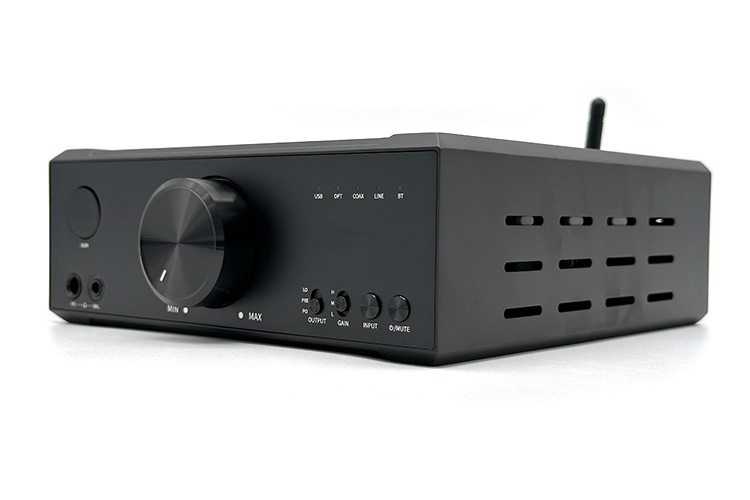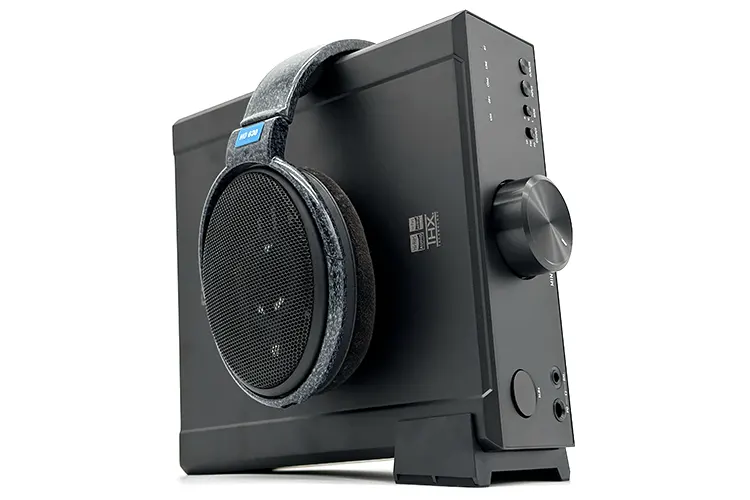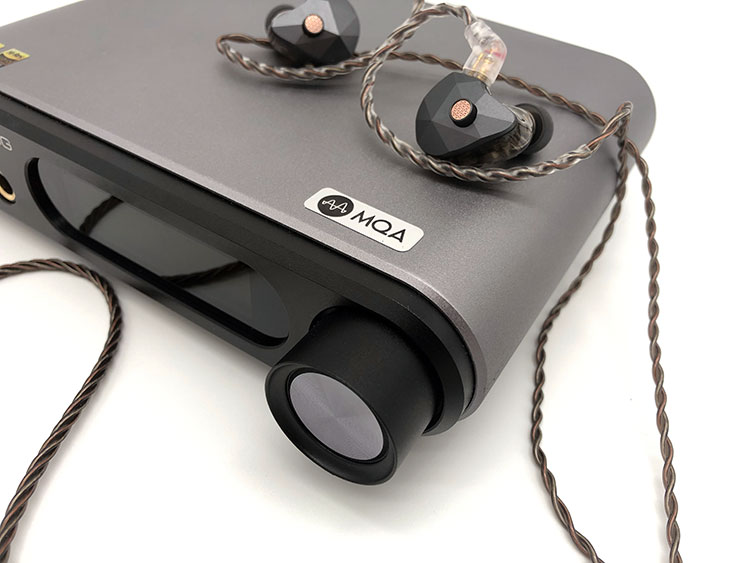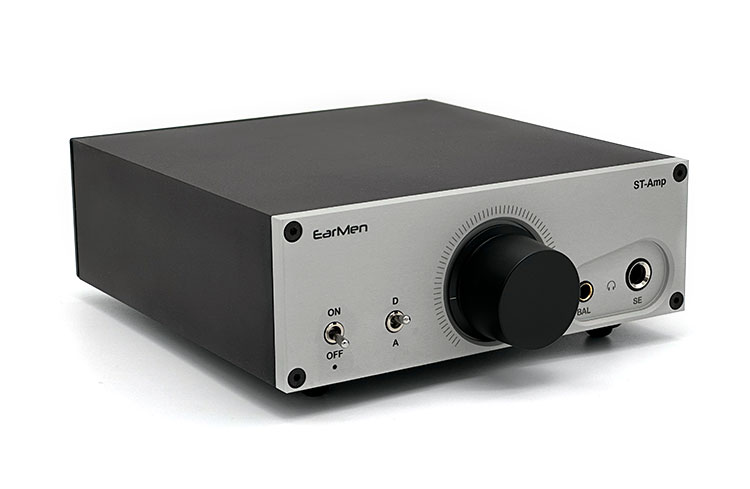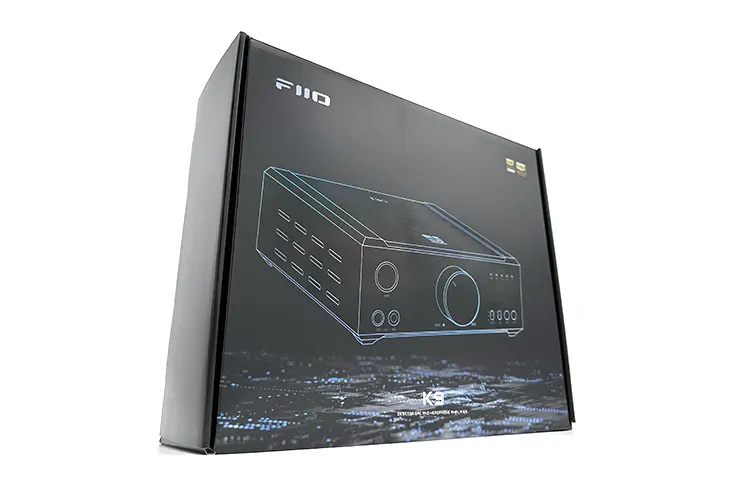Synergy
Power
With three hardware-level gain settings and up to 2W of power, the K9 has some serious grunt but still plenty of control for sensitive gear.
The low-level gain for example curbs the 2W capable THX AAA 788+ amplifier enough for sensitive gear like IEMs, thus removing any noise. In the same way, switching to the high gain will increase the headroom of the volume wheel which I found useful with the two headphones I paired.
I started using the K9 in single-ended mode and then later moved to the balanced output. With the Hidizs MS5, I had to use the 6.35mm adaptor since it has no 3.5mm jack but at least the low gain setting proved to be compatible maintaining a 10 to 11 o’clock position.
Jumping to a beefier headphone still in single-ended, my Audio-Technica ATH-ADX5000 challenged the K9 a bit more since it easily reached the noon position in mid-gain. It got back a bit more headroom in the high-gain setting.
With a balanced cable for the Sennheiser HD600, the story was quite similar to the ATH-ADX5000. It has more headroom though when compared which is expected since there is now more power available and the HD600 is also not as inefficient.
Pairings
Most of the listening impressions I did were through the ATH-ADX5000. And with enough power in-store to drive the dynamic drivers, the K9 did well in showing why these headphones are the pinnacle of Audio-Technica’s open-back designs.
First of all, the mix in timbre between the two will reward those looking for a more fluid sound to come out of the ATH-ADX5000. Since the K9 has the individuality to not remain lifeless, it was able to add some life to the otherwise sterile ATH-ADX5000.
Since I am plugging a highly revealing set of cans though, the K9 is still falling a bit short in pushing the drivers to the limits when it comes to detail retrieval and texture.
The K9 is adding softness to the ATH-ADX5000 tweaking the low-end to be richer and nicer to the ears. If anything, the K9 performed surprisingly well in the treble region where it showed a more dynamic and textured performance.
Switching to a more familiar set of headphones, the HD600 was a nice change of pace producing friendlier guitar twangs and more organic vocal traits. And since the K9 stages well, even with the merged size of instruments, the HD600 doesn’t feel claustrophobic or too intimate.
Listening to some piano, the HD600 is not as hurried as the K9. The reverb is still not very etched but the HD600 is careful enough to not construct the edges as too dull. I like that the HD600 was also able to set the energy similarly to the ATH-ADX5000 where the key presses aren’t outshined by the width of the echo.
Select Comparisons
FiiO K7 BT
Technical
I’ve mentioned it briefly before that the K7 BT is designed around an AKM DAC. And truly balanced like the K9, the K7 BT also divides up the work for each channel into a dedicated set of AK4493SEQ chips and THX AAA 788+.
The THX amplifier of the two starts at the same 2W of power for 32Ω loads but the K7 BT will show a weaker performance as the impedance of the gear paired begins to climb.
The original K7, not the K7 BT, was missing a Bluetooth receiver. In answer, this latest BT version from FiiO uses the same QC5124 chip from Qualcomm for wireless compatibility to all modern formats like LDAC, AAC, and more.
Both being from FiiO and wireless capable, it is obvious that the two can connect seamlessly to the FiiO Control App. Once inside, however, the K9 offers a multitude of features not available on the K7 BT.
Design
The K7 BT is a simpler and more rounded device that bears minimal similarities with the angular and bulky K9. It couldn’t be ignored though that once you fire up both units, the glowing ring around the massive volume wheel in the center is an easy common denominator.
The arrangement of the features upfront of the two units has completely switched sides from one another. What is on the left of the K9 is on the right of the K7 BT.
Instead of maintaining a uniform design, FiiO has opted for a slightly diverse approach which in a way makes the two stand on their own a little bit.
Performance
If the dash of bass lift on the K9 isn’t enough, then the K7 BT might give that extra energy to you. Predictably though, it is a lot looser in image tightness and shows a bit of hollowness in each wallop when compared.
Driving a more impactful mid-bass, the K9 has a cleaner and more intricate appeal. The extension of the low-end drops faster on the K7 BT which puts the more expensive device ahead in filling the room with depth.
I was initially surprised to hear the two get quite close with string timbre. However, it also became apparent how much detail was left out in the K7 BT.
The K9 can piece together an additional layer of depth in a strumming passage. As I repeated the same part over and over again, I also observed that the upper midrange of the K7 BT was brighter and thinner.
The same remark continues to the treble region where rock songs get a brighter and harsher feature. Lacking as well in dynamics, instruments like electric guitars will have some parts smoothed out and drop in excitement.
Topping DX5
Technical
The DX5 has been out for a while now and is already using the same ES9068AS chip the K9 has and is in a dual DAC configuration.
For those expecting a truly balanced XLR headphone output in front like the K9, the proprietary NFCA amplifier of Topping, unfortunately, fuses the signal into the same single-ended signal of the 6.35mm output.
If you have MQA files in your library though, then the DX5 has you covered. It will be less powerful though for less efficient headphones like the HD600 since it can only put out a maximum of 1.8W of power for 32Ω gears and this number quickly goes down as the impedance of the headphone increases.
Design
A promising entry from Topping, the DX5 was originally showcased with the intention of impressive visuals and modern design. And with its pleasing two-tone chassis and carefully placed angles helping its case, the DX5 in a way looks a lot hipper than the titanic impression of the K9.
It is also to be noted that the DX5 has an OLED screen. Though, I don’t think it is a massive upgrade since the graphics are quite old-school.
The fact that the K9 has an accompanying full-featured app more than eclipses the lack of a display. I also like the niftier façade of the K9 while still being friendly for day-to-day usage.
Performance
I’m getting similar energy from the two in the bass region though the DX5 immediately seems to not have the same level of definition and control as the K9. Lagging in tightness, the DX5 is softer and more smoothed out. The K9 is also not the most etched-out device out there, it simply has more finesse.
Piano keys on the DX5 are duller in comparison as they pull up the soft vibrato for supplementary emphasis. The K9 on the other hand has a surer inflection that is more realistic building the momentum more quickly for a more gripping sensation.
The DX5 felt like it is trying to diffuse the scene and add some scale whereas the K9 feels more comfortable in staying tidier and honest.
Electric guitars on the DX5 have less height and texture than the K9. Not quite as harsh and thin when compared to the treble of the DX5, the K9 handles brisk notes a lot nicer, layering and separating each instrument with better execution.
EarMen ST-Amp
Technical
While the ST-Amp also boasts a fully balanced internal architecture, there is only a single ES9280 DAC feeding to the diverging path going towards the separate amplifiers for the two channels.
Not only is the DAC less impressive than the K9, but the power output is also slightly more limited at 1.85W for the same load.
What I like about both devices is the flexibility of having not just an analog pre-out but inputs as well. The option of using balanced connectors is available on both units although the ST-Amp has a more compact 4.4mm installed for its balanced pre-out instead of full-sized XLR ports.
Digital input though is a lonely affair for the ST-Amp. Users of the EarMen DAC/amp should be content with only having USB as a form of communication with the DAC chip inside. There’s no Bluetooth either so wireless listening is not possible unlike with the K9.
Design
With a higher asking price than the K9, the ST-Amp doesn’t look like much when compared. The cornered design by EarMen is a lot more industrial not hiding the screws holding the unit together in front which makes the K9 seem overly dressed.
The K9 out-of-the-box doesn’t have any feet installed underneath because it is up to the user whether they want it sitting horizontally or vertically. The ST-Amp on the other hand is sat atop an odd-numbered set of tall rubber feet which sometimes causes the unit to rock.
Both units don’t have a display. The K9 though is fuller featured so not only are there more bits and pieces to play around with, but there is also a clever glowing LED ring around the volume wheel for some level of feedback.
Performance
The ST-Amp is capable of better sub-bass extension lingering slightly longer than the K9 without blurring with neighbors. It is the K9 though that expresses a cleaner and tighter dispersion of a kick drum.
Still, depending on what you’re looking for, there is a stronger punch and crisper bite to be expected out of the ST-Amp.
With less flavored timbre for pianos, the ST-Amp is sweeping away quieter sections more easily in bias for the upper notes. I like the rich undertone of the K9 as it reflects both parts in a more even case.
The two devices have almost equal detail retrieval with raspy vocalists. The difference is that the K9 has a softer and more rounded delineation while the ST-Amp has a drier and airier trait. Listening to both, I wouldn’t say there is a strong lead here since personal preference comes in.
Giving more flavor and width to violins, the K9 is better at creating a rich and serenading illusion against the thinner qualities of the ST-Amp. Dynamics is on par though I’m getting a bit more height and scale with the K9.
Our Verdict
Even with a Sabre DAC, the K9 thankfully didn’t disappoint in showing off its charms delicately flavoring each melody with a refined character. To be precise, it wasn’t a dreary and featureless affair listening to the base version of FiiO’s current TOTL.
But no matter how well FiiO may have assembled and tuned their new device, a few nitpicks still made it through.
Not really a deal breaker, but the lack of delineation in the bass region could certainly use more bite. Also, some gears will bring out a fatiguing shout coming from the K9 just like with my ATH-ADX5000.
It is thrilling to see how much performance is crammed into the K9. With a full-featured set of IO and a powerful amplifier, the unit is not just great sounding but future-proofed as well.
FiiO K9 Technical Specifications
- DAC: ES9068AS*2
- Decoding Chip: XMOS XUF 208
- Amplifier: Dual THX AAA 788+
- Bluetooth Chip: QCC5124, Bluetooth 5.1
- Outputs: 6.35mm/4.4mm/XLR-4/RCA/XLR
- Inputs: USB/OPT/COAX/RCA/4.4mm
- Output Power 1: L+R³2000mW+2000mW (32Ω balanced/THD+N<1%)
- Output Power 2: L+R³780mW+780mW (300Ω balanced/THD+N<1%)
- Weight: About 2660g
- Dimensions: 200×224.5x72mm (excluding feet)

